| New York Giants
vs.
Notre Dame All Stars
December 14, 1930
|
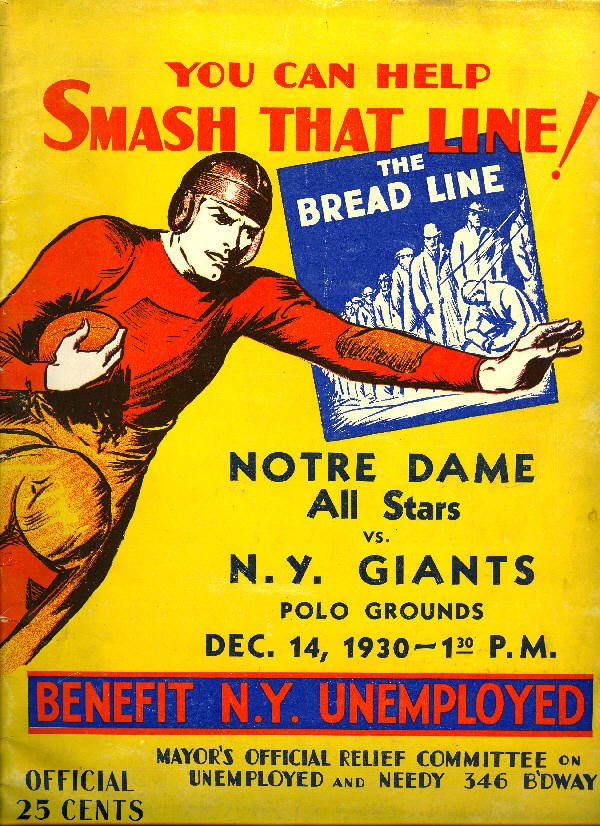 |
as told by Barry
Gottehrer in “The Giants of New York, G. P. Putnam’s Sons, New York, 1963 |
(At the end of November 1930,) seemingly on their way to a
second NFL championship, the Giants, physically battered by the Packers, slumped
drastically the next two weeks losing 7 6 to both Stapleton and the Brooklyn Dodgers. In
just two Sundays, one of the Giants' brightest seasons and hopes for a league title had
faded away. Two games against Frankford and Brooklyn remained on the schedule, but Bill
Abbott, one time sports editor of the New York World and press agent for the NFL and
Giants, was thinking ahead.
To raise funds for Depression struck families, New York mayor Jimmy Walker had extended an
open invitation to all teams, both college and professional, to help raise money for his
Committee on Unemployed. Basketball and college football games had already contributed
some money. Why didn't the Giants play a post season exhibition game with all the funds
going to the mayor's committee? The Giant owner had lost his $526,812 suit against Gene
Tunney and Billy Gibson (later appealed and settled out of court), but with the home
season now over, T. J. was particularly pleased with Mara Tech, a name bestowed on the
Giants by Bill Corum and a dozen other sportswriters. Barring a second Stock Market crash,
the Giants would finish 1930 at least $20,000 ahead, and Mara was feeling in a charitable
mood. There was only one problem: What team could the Giants play?
"Why not Notre Dame?" suggested Bill Abbott. It was a wonderful idea. Ever since
Mara had bought into professional football. in 1925, a controversy had raged about the
relative strengths of the top college and NFL teams. Notre Dame was heading for its second
consecutive national championship. And the Giants were one of the NFL's top teams.
Sportswriter Dan Daniel was named chairman of the game committee and given the job of
selling Notre Dame's Knute Rockne on the idea. Rockne was all in favor of it, but Notre
Dame was playing Southern California the week before on the West Coast, and the Fighting
Irish didn't want to schedule two big games in so short a time. Rockne offered another
suggestion: How about the Giants playing an All Star team of Notre Dame greats, past and
present?
Mara and his players liked Rockne's suggestion even better than their own. "The
minute it was definite we were going to play, I told the mayor that Notre Dame would be
lucky to make a first down against us," said Mara. "We were much too big a
football team." |
| 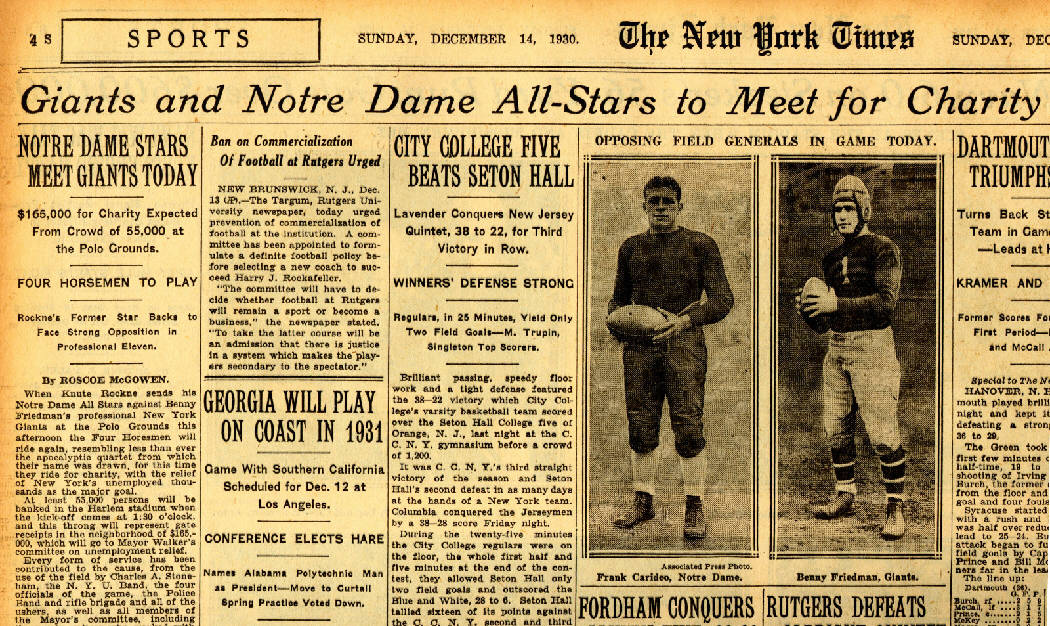
|
The Giants still
had two league games left, but everyone was thinking about December 14 and the Fighting
Irish. Andrews became so obsessed with the thought of coaching against Knute Rockne that
it cost him his job. "He just got himself all worked up thinking about this great
meeting with Rockne," said Friedman. "He thought he had to be tougher with us
and pretty soon he lost control of himself completely."
When the Giants returned to their dressing room trailing Frankford, 6 0, Andrerews started
to berate his players, threatening fines and even firings. He made considerable noise but
little sense, and suddenly he turned to Friedman, who, with Cagle, had been held out of
the game because of injuries. "And you, Friedman," Andrews shouted, "can
lose your money just like anyone else." In the second half, Hagerty scored twice and
the Giants won, 14 6. Early the next morning, Friedman and Owen went to see Tim Mara. The
Giants’ owner, who'd had little admiration for Andrews since he failed to follow the
front office's orders and lost New York University star Ken Strong to Stapleton in 1929,
listened carefully and told the two players he would take care of the coaching problem
immediately.
When the Giants stepped onto the Ebbets Field infield the next week, Leroy Andrews no
longer was head coach. For the remainder of the season, Friedman would run the team and
Owen would assist him. Before an overflow crowd of 20,000, the Giants crushed the Dodgers,
13 0, on touchdowns by Friedman and Moran. When Green Bay also lost, 21 0, to the Chicago
Bears the same day, the Giants still had a mathematical chance for the title. If the
Packers, 10 3, lost their final game to Portsmouth, a team they had beaten 47 13 earlier
in the season, the Giants, 13 4, would be NFL champions. The Packers didn't beat
Portsmouth, but they didn't lose either. They battled to a 6 6 tie and backed into their
second straight title, beating out New York by only four percentage points, .769 to .765. |
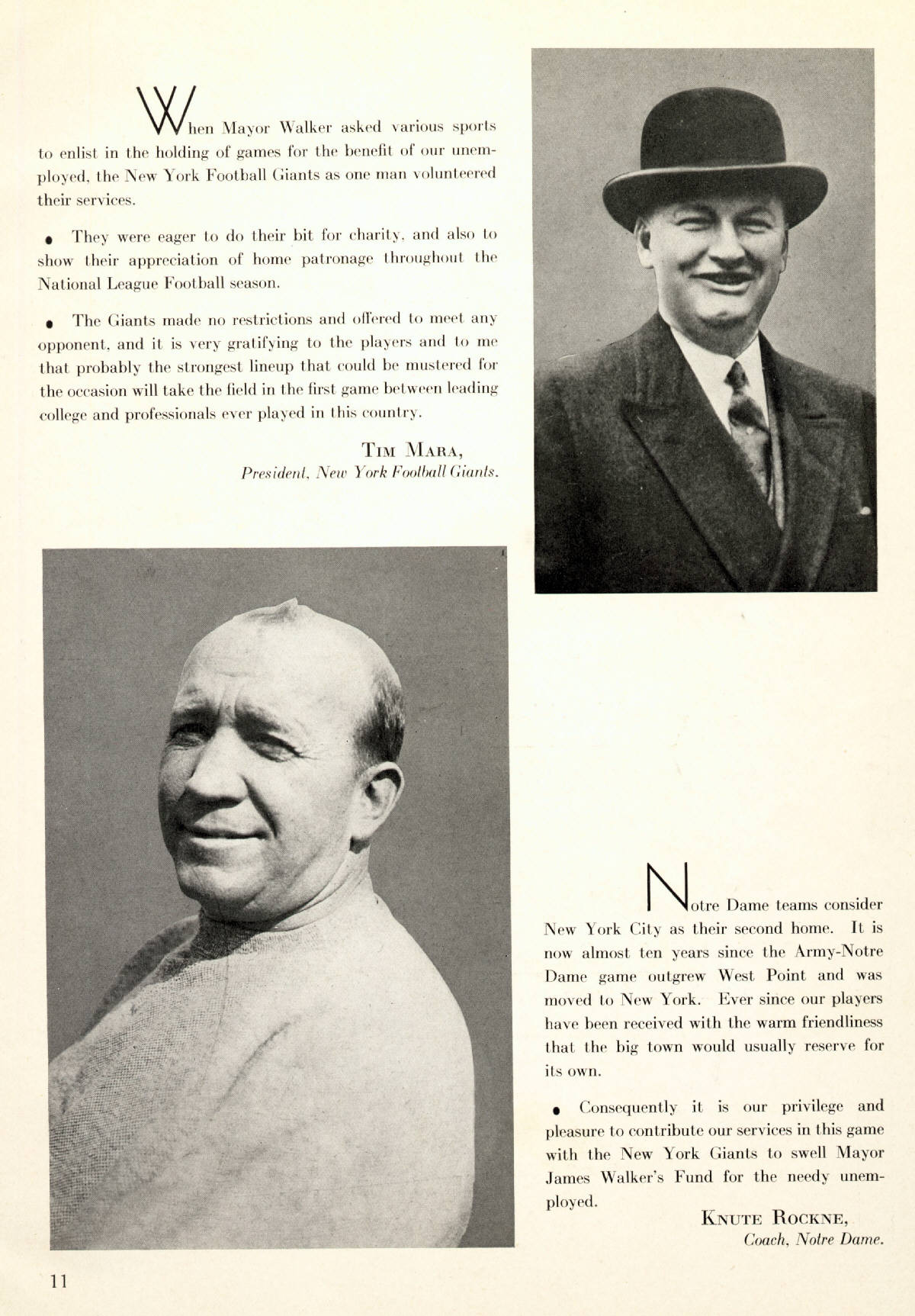 |
Rockne began
gathering his former stars together in South Bend on Tuesday, practiced for four straight
days, and then climbed aboard a Chicago sleeper, arriving in New York's Grand Central
Station 8:30 Saturday morning. In every newspaper in town, the biggest ads of the pro
football season announced:
SEE THE FOUR HORSEMEN RIDE TOGETHER AGAIN
By the time Rockne and his players climbed off the train in New York, $100,000 worth of
tickets had been sold for Sunday's game. Fifty six prominent New Yorkers had bought boxes
at $100 each, and Charles Stoneham, owner of the baseball Giants, had donated the Polo
Grounds rent free. From Grand Central, Rockne and his 32 All Stars were driven to City
Hall where they met Mayor Walker and were interviewed over a three station national radio
broadcast.
While the Fighting Irish were getting the grand tour, the Giants were at the Polo Grounds
early Saturday morning for a short workout and signal drill. By the time the Notre Dame
team arrived shortly before noon, Steve Owen was the only Giant still at the ball park.
Spotting Rockne, Owen walked over to the famous coach and introduced himself.
"Oh sure, you're one of the Owen boys," said Rockne, quickly applying the
needle. "There's two of you and both of you are very, very tough to play against.
Don't know what we'll do with you tomorrow."
"Don't know about that," said Owen. "We'll be glad to do anything to help
you today, but tomorrow what we do won't be to your advantage."
As soon as Owen left, Rockne told Harry March, who bad escorted him to the field, he
couldn't watch the Notre Dame practice. Rockne also told the secretaries in the Giant
office to keep their eyes on their work and off the field down below. If Rockne had
something special planned for the Giants, he wasn't going to let other people see it
before the game.
|
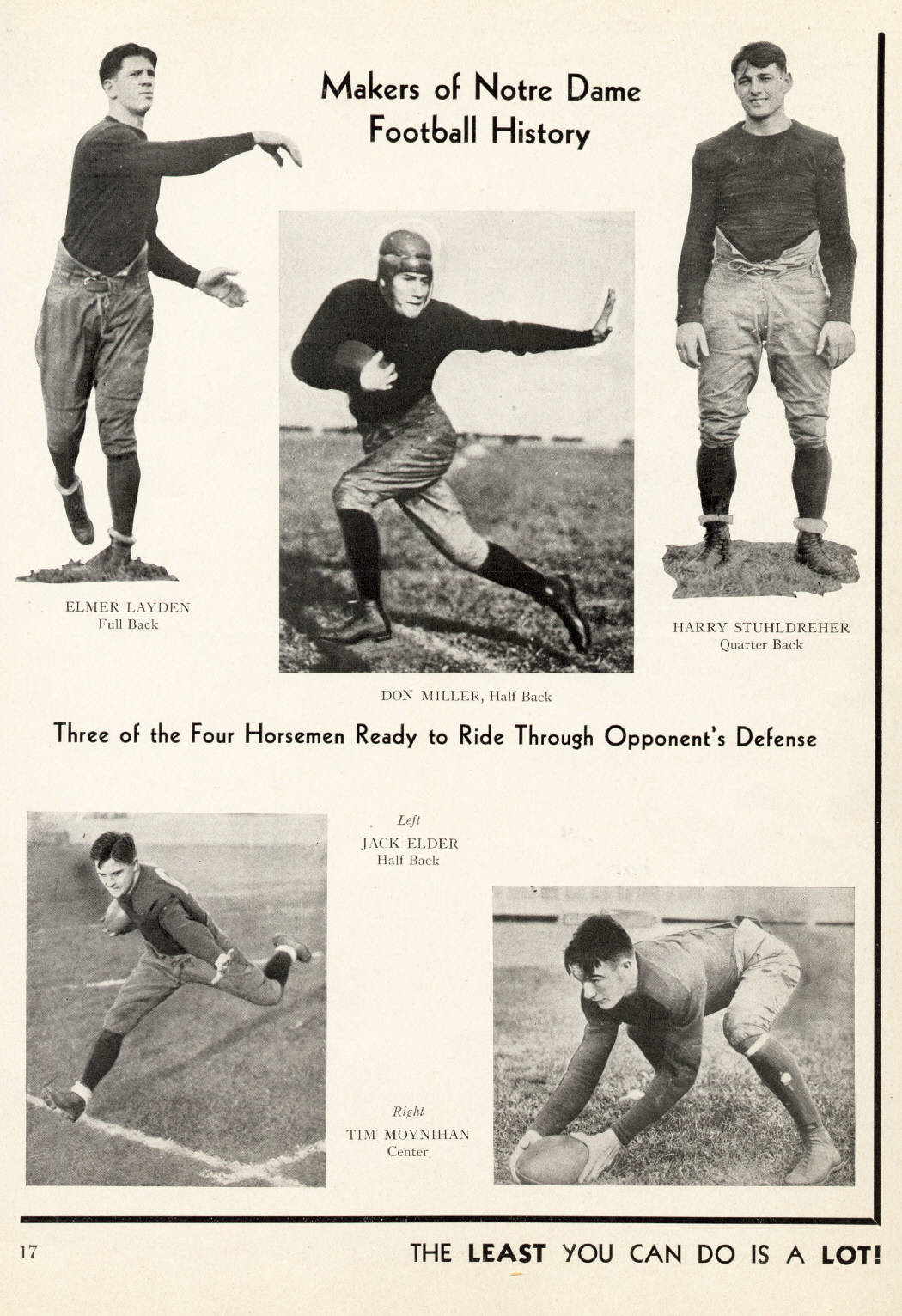 |
One hour before
game time, more than 50,000 fans were seated in the Polo Grounds, brightly decorated for
the day with red and blue bunting on the Giant side and blue and gold on the Notre Dame
side. Watching the pre game festivities, Mara had to smile. There were more musicians than
football players in the Polo Grounds. Bands from New York University, the Police
Department, and an American Legion post beat out endless choruses of "Cheer, Cheer
for Old Notre Dame" and "East Side, West Side."
In the dressing rooms, the sounds of music made little impression. Seated on the rubbing
table, Friedman was having his ankles taped when Knute Rockne, leaning heavily on a cane,
limped over to him. Owen had told Benny that Rockne and his players were extremely
confident, and Friedman was anxious to see for himself.
"How are you feeling?" asked Friedman after they had shaken hands.
"Just so so," said Rockne. "How about you?"
"Fine," said Benny, "just fine."
"That's too bad," said Rockne. "We've got a lot of boys who think they're
football players. They may have a lot to learn today. " Rockne paused. "How
about some concessions?" he asked. "Free substitutions?"
"Fine," said Friedman.
"Ten minute quarters?" asked Rockne.
"Twelve and a half minutes," said Friedman impishly as they shook hands again.
"Anything else?"
"Yes, one thing," said Rockne. "For Pete's sake, take it easy.
Minutes later, Rockne gathered his All Stars for his traditional pre game pep talk.
Looking around him, he saw the finest football players Notre Dame had ever produced the
Four Horsemen, Harry Stuhldreher, Jim Crowley, Elmer Layden, and Don Miller, who had not
worn Fighting Irish uniforms in six years; five of the Seven Mules, Adam Walsh, Joe Bach,
Rip Miller, Noble Kizer, and Ed Hunsinger; Jack Chevigny, star of the 1928 team; Jack
Cannon, John Law, Tim Moynihan, Ted Twomey, Joe Vezie, John Gebert, and Jack Elder of the
unbeaten 1929 team; Bucky O'Connor and Frank Carideo of the undefeated 1930 team; and Hunk
Anderson and Glenn (Judge) Carberry, two former Notre Damers who had played in the pros.
For Rockne, who was to die in a plane crash before the next football season, this was the
last time he would coach a Notre Dame team. "Fellows, these Giants are heavy but
slow," he told his players. "Go out there, score two or three touchdowns on
passes in the first quarter and then defend and don't get hurt."
The Notre Dame All Stars were lucky to escape with their lives. The Giant line, which
averaged close to 230 pounds, dwarfed the Notre Dame players as the two teams trotted onto
the field. On the first play of the game, halfback Johnny Law, a muscular 170 pounder,
took a good look at Steve Owen, a beefy 245, and turned to referee Tom Thorp. "Can
you tell me," he asked, "how much time is there left to play?" |
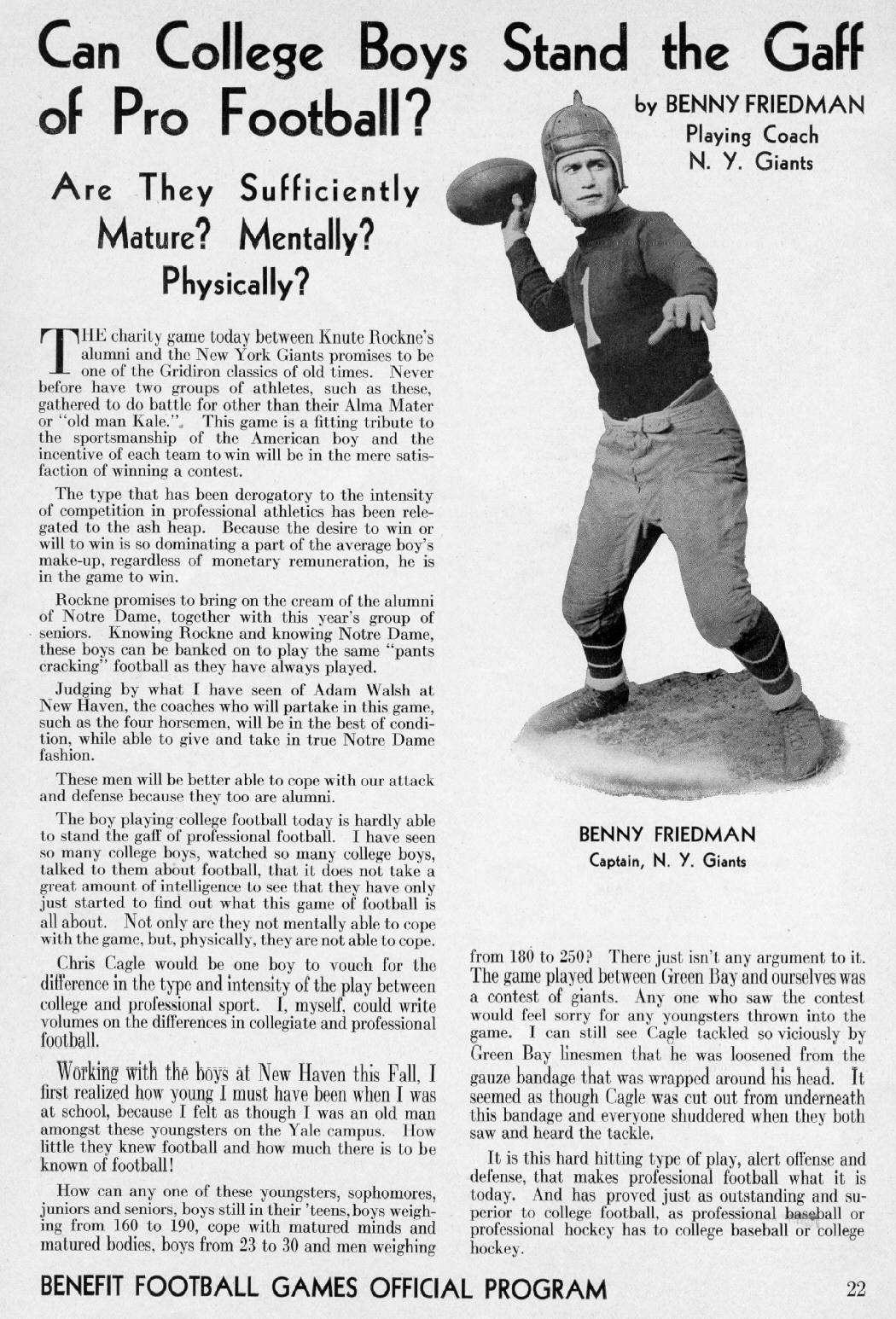
|
With Al Smith and
Mayor Walker in the stands and coach Rockne bundled in blankets on the sideline, the
Giants kicked off and the slaughter began. Within two minutes, Bill Owen broke through the
Notre Dame line and dumped Stuhldreher in the end zone for a safety and a 2 0 lead. The
Giants kicked off again but the Four Horsemen couldn't move the ball against the mammoth
New York line. All told, Notre Dame backs gained 5 yards and lost 17 in the first quarter
and couldn't advance past their own 40. Seven minutes into the first quarter, Sleepy Jim
Crowley collapsed under two Giant tacklers, picked himself up, and limped off the field.
"Why, only two men hit you!" said referee Thorp, grinning.
"You're right," answered Crowley, "but I didn't think they were going to
come at me from the roof of the grandstand." Crowley was lucky; he was through for
the afternoon.
Elder replaced Crowley, picked up 7 yards in one carry, and the Giants took over again.
Friedman scored early in the second quarter on a 4 yard plunge and New York led 8 0. A
kickoff, three running plays, and a punt, and New York was driving for another touchdown.
Expecting a pass, right guard Noble Kize whispered to center Adam Walsh, "I'm going
to pull out on this play and take the inside back on pass defense. So cover me here."
Walsh, who had already taken a full college season of pounding from the Giant line,
grabbed Kizer by the elbow. "What, and leave me here all alone?" Walsh said.
"Not on your life." In a rare display of teamwork, the two Notre Dame linemen
waited until the Giant center had shifted the ball, and Walsh then raced Kizer to the
safety of the sidelines.
|
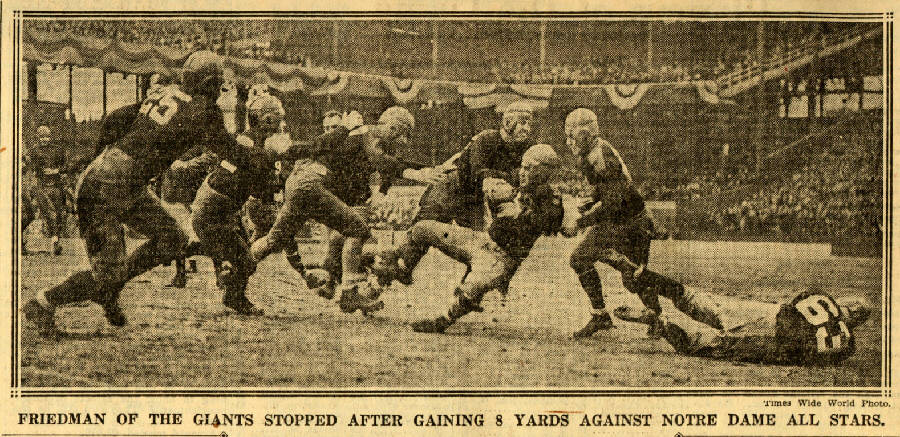 |
Mixing his plays
expertly, Friedman moved the ball to the Notre Dame 22. With third down and 7 yards to go,
Friedman thought of the three principles coach Fielding Yost had instilled in him at
Michigan.
1. Study the defense: Notre Dame was in a seven man line.
2. Play for lateral position: The Giants already had the ball close to the middle of the
field.
3. Find the disciple of Barnum: On every previous third down situation, Notre Dame's left
guard Hunk Anderson had been playing the percentages. Expecting Friedman to pass, he would
pull out of the line and drop back to defend about 5 yards behind the middle of the line
of scrimmage. Hunk was Benny's man.
Once again Friedman took the ball on a direct snap, faked a pass, sending Anderson
lumbering out of position, and then sliced over the exact hole Hunk had vacated. Once
through the line of scrimmage four Notre Dame players got their arms around him, but
Friedman pulled free and raced into the end zone "That," said veteran umpire Tom
Thorp, "was one of the finest calls and executions I've ever seen." Friedman
kicked the extra point and, at half time, New York led, 15 0.
Rockne was a thoroughly beaten man when Harry March 'Walked with him back to the dressing
room. "I came here to help a charity and at a lot of trouble," said Rockne.
"You are making us look bad. Slow up, will you? I don't want to go home and be
laughed at. Lay off next half."
The Giants had proven their point and played many second stringers throughout the second
half, but even this was too much for Notre Dame. Starting on their own 37 in the third
quarter, Elder lost 4 yards, Stuhldreher 9, Elder 13, and Elder then punted to his own 42.
Cagle then raced 15 yards, his longest gain as a Giant, and Hap Moran hit Campbell for the
final touchdown. The score of 22 0 did not come close to showing the pros' superiority.
The Giants ran up eight first downs to one for Notre Dame, outrushed the collegians 138
yards to 34, and completed seven of nineteen passes for 94 yards. Notre Dame's passers
didn't complete a single one in nine attempts and two were intercepted. Notre Dame never
got past its own 49 and the Fighting Irish got that far only once, in the second quarter.
In four quarters of football, Notre Dame's two longest gains were Elder's 7 yard run in
the opening quarter and Rex Enright's 12 yard dash for the only first down in the second.
In the Notre Dame dressing room, the players waited for Rockne's parting words. "That
was the greatest football machine I ever saw," said Rockne. "I am glad none of
you got hurt." |

|
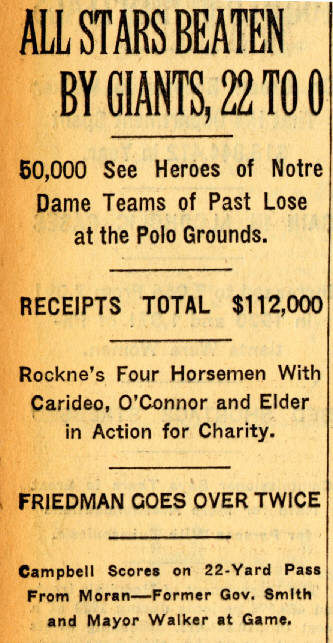 |
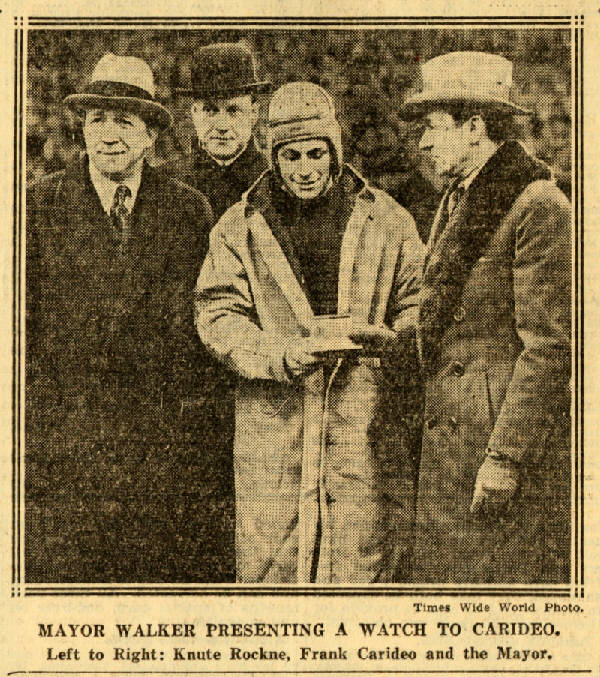 |
After showering and
dressing, Friedman headed upstairs to see Tim Mara in Charles Stoneham's private office.
The Giants had taken in $115,153, but one totally unexpected problem had cropped up. Notre
Dame, which had contributed its services for living and traveling expenses only, had
turned in a sizable list of expenses. It was ridiculously high, finishing off with:
MISCELLANEOUS $5,000.
Mara showed the Notre Dame expenses to Friedman and then pointed to the last item.
"Miscellaneous?" said Benny. "I don't remember him. Where did he
play?"
Mara chuckled and Friedman offered a suggestion. "Look, let's knock off fifteen
thousand dollars to cover the expenses and give the city a check for an even hundred
thousand," said Friedman, who had devoted his services free of charge. "Nobody
will know the difference and you won't wind up losing your own money." |
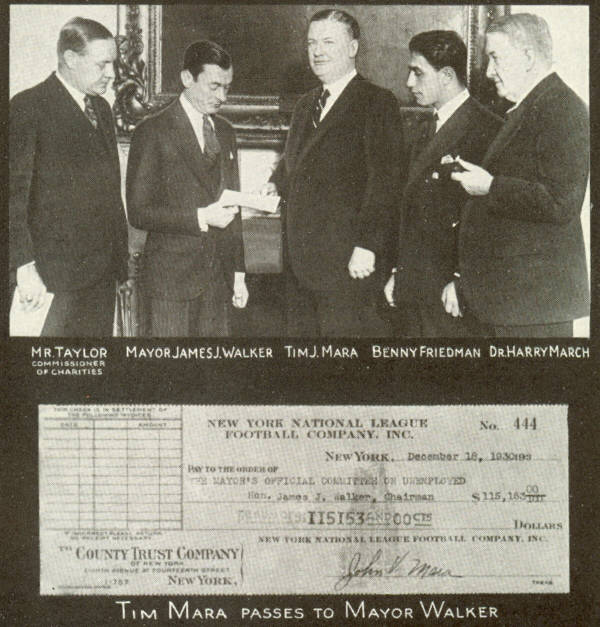 |
Mara thought it
over, then reached his decision. Four days later, Mara, March, and Friedman visited Mayor
Walker at City Hall and turned over a check for $115,153. He had lost money on the charity
game and the Giants had lost a final exhibition to Stapleton, yet Mara was happier than he
had been since first buying the franchise in 1925. The team had had an excellent season on
the field, he had finished $23,000 ahead for the year, and he had beaten Knute Rockne and
the Notre Dame All Stars, a collection of some of the best football players in history.
What difference did it make if many of the All Stars were far from top condition and had
practiced together for less than a week? What did matter to Mara was that for the first
time since Red Grange, Giant football had created a noise picked up by sportswriters and
listened to by New York sports fans. On December 14, 1930, professional football in New
York had taken another giant step out of the dark ages.
|
 |
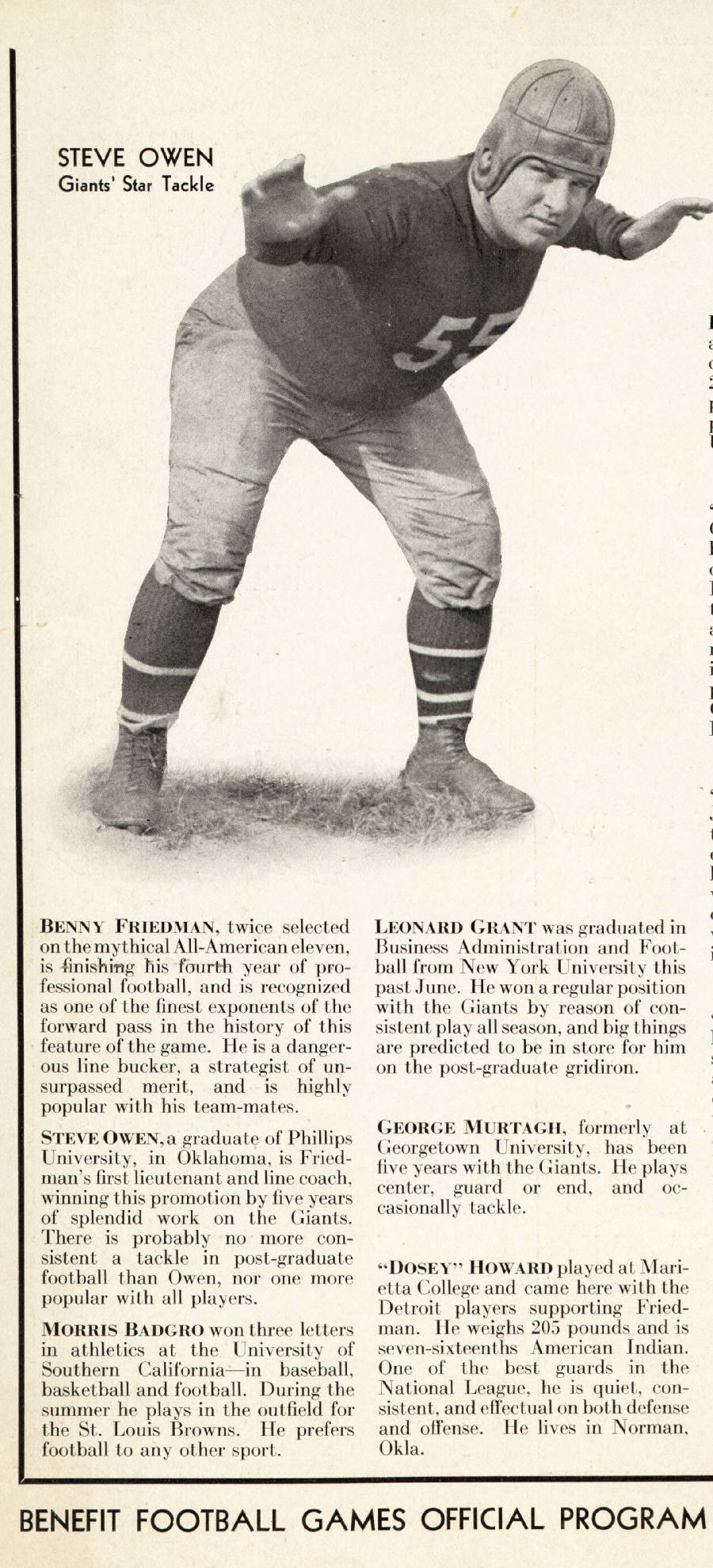 |
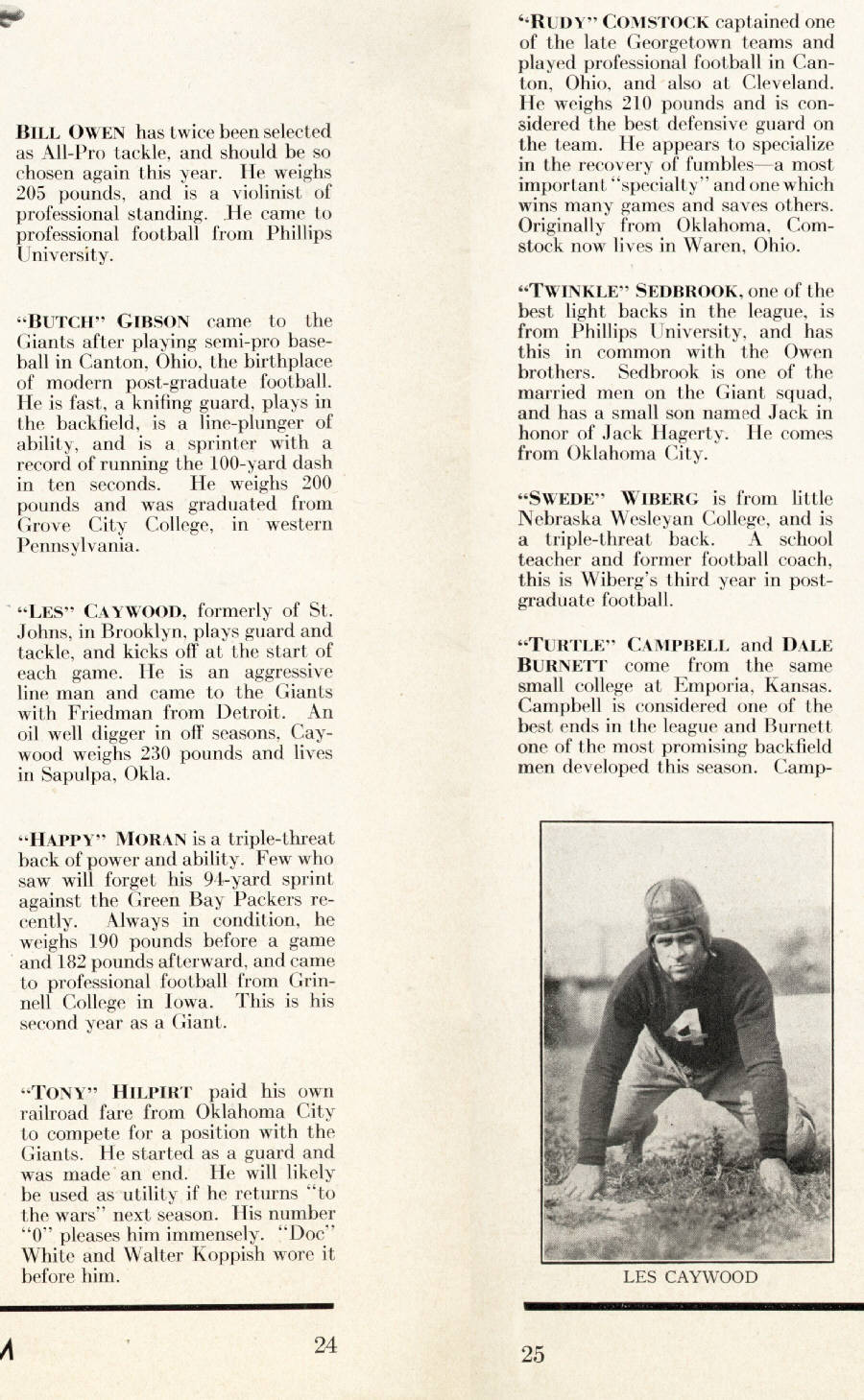 |
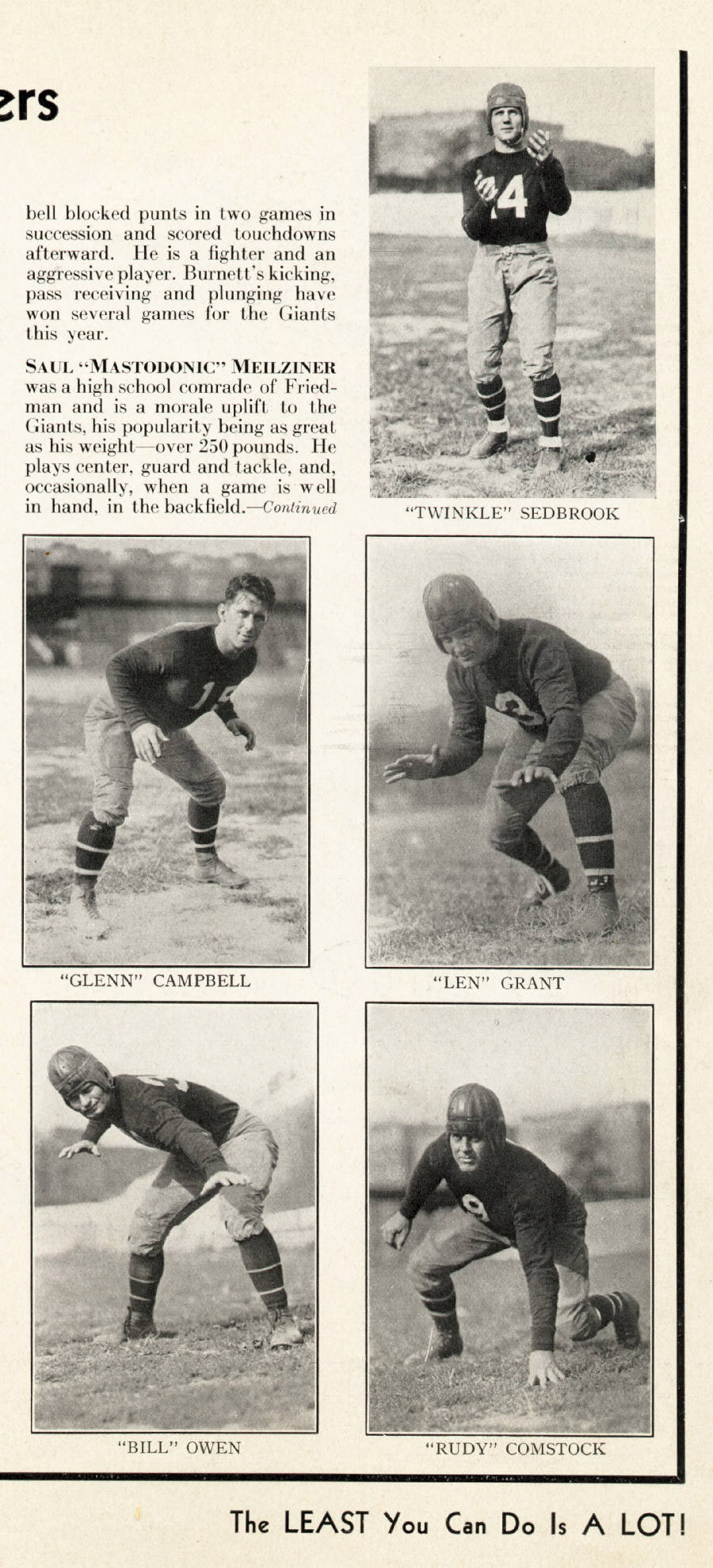 |
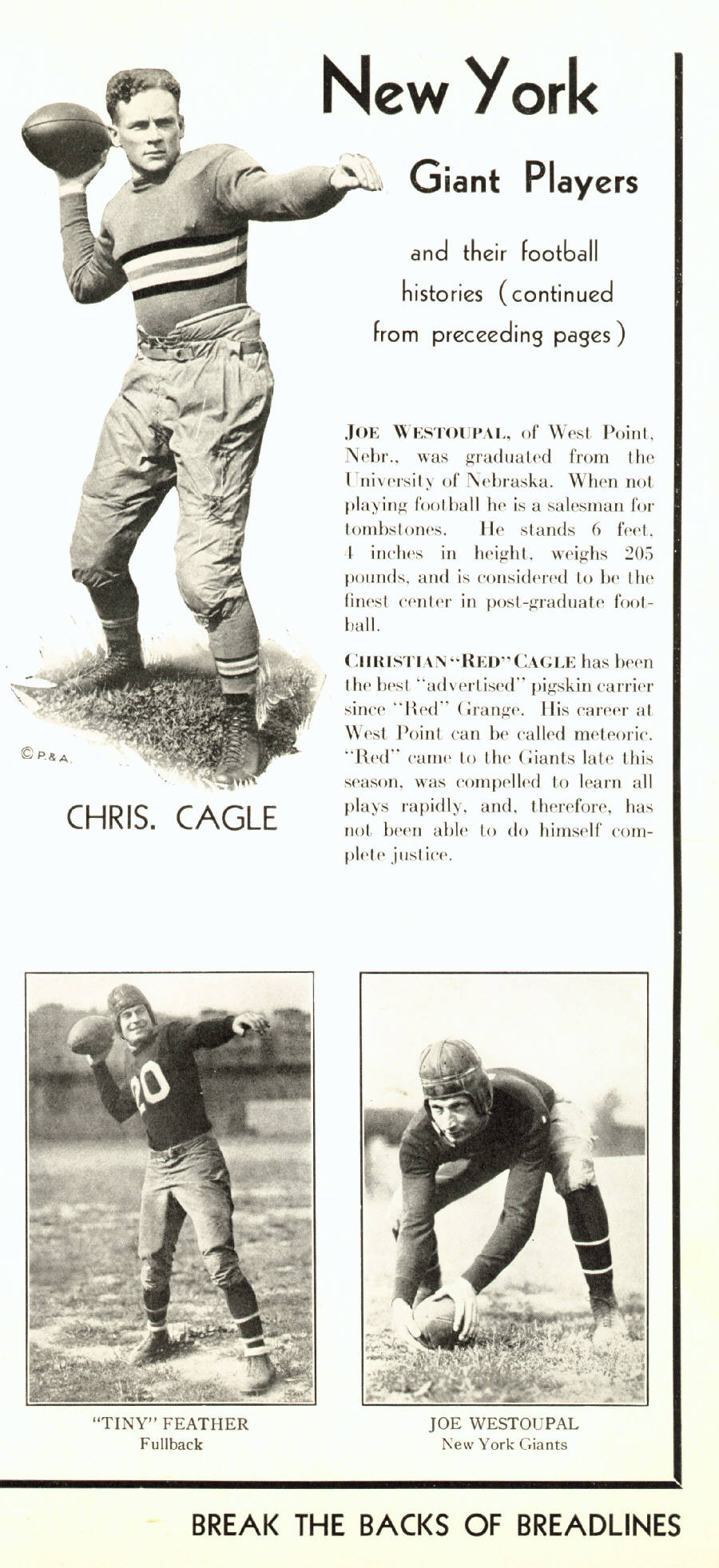 |
 |
| Home |















